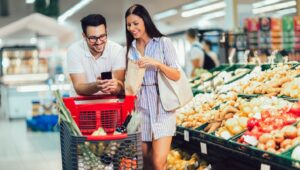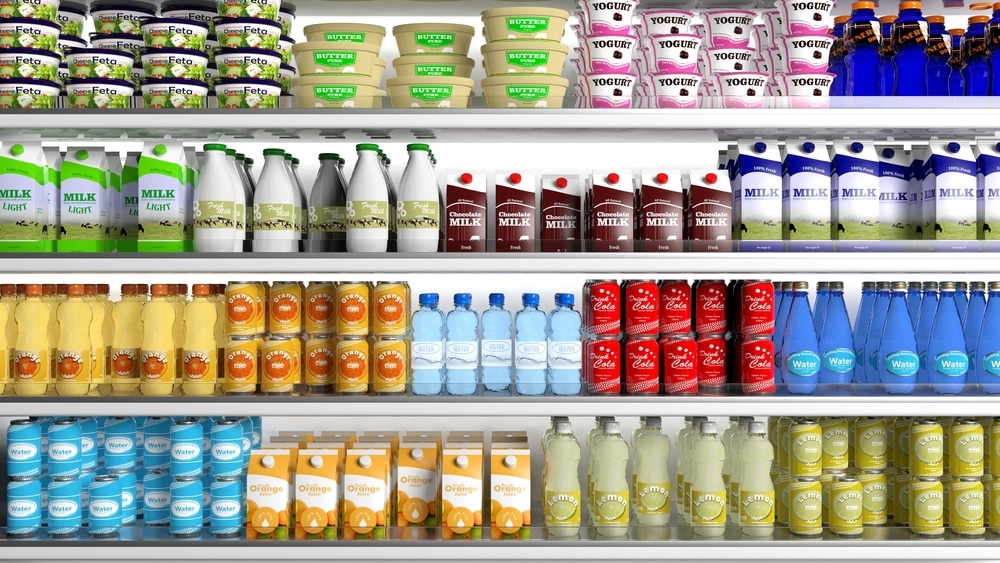We don’t have to tell you twice, but running a brick-and-mortar grocery store can be costly. Naturally, you want to maximize your returns when you’re shelling out around $160,000 just on inventory. In some ways, you’re competing against local competitors, but you’re increasingly competing against eCommerce players as well.
The share of US consumers who purchased groceries online in the past year jumped from less than a quarter to more than a third, with Amazon and Walmart driving sales. Nearly 40% of those surveyed said they plan to shop for groceries online in the next 12 months, but there is growth potential in the 21% who “don’t know” if they will buy online. This may leave retailers wondering how to increase sales in their grocery stores.
Is CPG eCommerce a Threat to Grocery Store Sales?
Despite the surges and impressive forecasts, the reality today is that only 2.7% of the $743 billion CPG market gets purchased online, up from 2.2% in 2018. Even if it reaches the estimated 8% share of US grocery sales by 2022, it’s still a relatively small amount of sales—something to consider, but certainly not a “threat” to physical supermarkets by any stretch of the imagination.
Online grocery shoppers tend to make infrequent purchases and buy in smaller amounts, according to research. Just 11.8% of online shoppers bought “most” or “all” of their groceries that way, so you can feel confident that eCommerce will not fully replace brick-and-mortar grocery stores. A recent report found that 71% of shoppers surveyed spent $50 or more shopping in-store, compared to just 54% of shoppers who spent that much online.
With that said, it’s a wise move to brace yourself for the uptick in eCommerce shopping by creating an online presence and linking up with a service provider like Instacart or Shipt to cater to those consumers who purchase online. Analysts believe that physical supermarkets will serve as the anchor for inventory fulfillment for customers ordering online, rather than a separate entity competing with online providers. Using mobile apps like Shopkick will bridge the gap between digital and in-store experiences, providing crucial information at the purchase point and rewarding shoppers for their loyalty.
How to Increase Sales in Grocery Store Environments
1. Give them retail therapy.
Remember what draws customers to physical stores. Sometimes it’s not even the products or the convenience so much as it’s the visceral experience that provides a way to de-stress from a long day or week of work—“retail therapy,” as it’s called. Nearly three-quarters of consumers admit to stress-shopping. Consider ways of redesigning or augmenting your space to make the trip more interesting and fun such as curated music, enhanced lighting, digital displays, interactive kiosks, and perks like a free drink or bite of food while shopping to improve your aesthetic.
2. Add trending items and departments to your inventory.
Grocery store growth has largely been fueled by the rise of organic and healthy options, specialty items, and innovations like meal kits and ready-to-go prepared foods. Supermarket departments are rapidly expanding to become more of the one-stop-shops people have come to expect—new sections like high-end bakeries and gourmet cheese shops, in-store bars and wine shops, larger beauty sections and sushi bars, Starbucks counters, and full-service banks.
3. Offer in-store promotions and deals.
In one survey, 84% of shoppers admitted that they go into the store for a need, but end up walking away with an impulse buy want due to an attractive promotion or deal. Online retailers often entice shoppers with free shipping offers and deep discounts, but you can do the same in-store.
4. Reconsider shelf space, shifting unique items to eCommerce operations.
 The internet is routinely turned to for “that one product you can’t get anywhere else.” More and more, retailers are relying on analytics to gain insight into consumer preferences. Start with a large selection and let consumers decide what you should or shouldn’t carry in-store. Be sure to have your best-selling eCommerce items available on shelves as well. Use online sales data to update, reposition, or replace low-selling SKUs in both physical and online shops. If a particular flavor isn’t selling well in-store, make it exclusive to your online store. Often, the highest productivity comes from a rotating selection of new and niche products that keeps the shopping experience fresh and exhilarating.
The internet is routinely turned to for “that one product you can’t get anywhere else.” More and more, retailers are relying on analytics to gain insight into consumer preferences. Start with a large selection and let consumers decide what you should or shouldn’t carry in-store. Be sure to have your best-selling eCommerce items available on shelves as well. Use online sales data to update, reposition, or replace low-selling SKUs in both physical and online shops. If a particular flavor isn’t selling well in-store, make it exclusive to your online store. Often, the highest productivity comes from a rotating selection of new and niche products that keeps the shopping experience fresh and exhilarating.
5. Bridge the online/offline gap with the integration of mobile applications.
Leading grocers and CPG companies understand that digital media must be part of the shopping trip planning process, according to research by Deloitte. A completely integrated digital strategy recognizes that shoppers use their mobile phones to find stores, make lists, check prices, research products, compare products, share content, and purchase. Offering an in-house app or partnering with a third-party mobile shopping app can enhance in-store product interactions and deepen the brand conversation, saving shoppers time, money, and hassle.
Kraft rewarded Shopkick app users who purchased baker’s chocolate, pudding, and marshmallows for the holiday baking season with “kicks,” which they could then put towards a free gift card of their choosing. Through Shopkick, Kraft was able to engage with shoppers along the full path to purchase, whether they were on their mobile devices at home, or in-store at the shelf. More than a quarter of shoppers converted to purchase all three items. Fifty percent of the Shopkickers said they hadn’t planned on buying any of those items when they first walked into the store. Overall, Kraft’s campaign garnered greater than 7:1 return on investment.
Find Out How to Increase Sales in Your Grocery Store With Shopkick
Digital is here to stay, but brick-and-mortar grocery stores aren’t falling by the wayside. Price, quality, convenience, and selection will always be the key drivers, no matter which shopping channel a person uses. A partnership with Shopkick lets you add value and enhance the in-store shopping experience while also rewarding and encouraging customer loyalty.
Digital is here to stay, but brick-and-mortar grocery stores aren’t falling by the wayside.
Looking for more information on modern tools that boost CPG sales in grocery stores? Read our partners’ success stories or contact us to learn how to appeal to mobile shoppers with Shopkick.
Image courtesy of Gts





